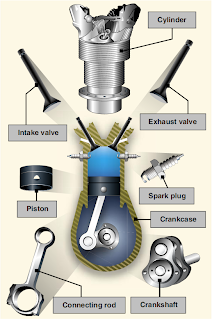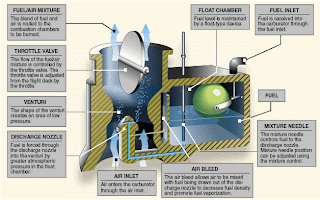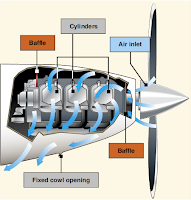Reciprocating Engines
Thrust is produced through converting fuel energy into mechanical energy (combusition in the pistons). Ignition in these systems is either through spark ignition or compression. Or typically 4-stroke vs. 2-stroke. Engines can further be classified by
-Cylinder Arrangement (Radial, In-Line, V-Type, or Opposed)
-Operating Cycle (2 or 4)
-Method of Cooling (Liquid or Air)
Two Stroke Compression occurs when air forced into piston is compressed (raising temperature hot enough to ignite). Use of fuel injection and pressurized air is common to improve efficiency.
Spark Ignition (4-stroke) engines are more common. Magnetos are normally located on the engine accessory housing.
Propeller
The propeller itself is like a small wing - warped over its length in attempt to maintain a constant angle of attack. There are two common types - Fixed Pitch and Adjustable Pitch
Fixed Pitch Propellers - are set by manufacturer and cannot be changed by pilot or operator. The pitch setting is ideal for one aspect of flight such as climb or cruise. Its advantages are price, simplicity, and low weight.
Tachometer is used as indicator of engine power with fixed-pitch propeller. The RPM is controlled by the throttle which controls amount of fuel/air flow to the engine.
Adjustable Pitch Propellers - Automatically governed or pilot controlled adjustment of propeller pitch. It converts high percentage of brake horsepower into thrust horsepower. It is more efficient than a fixed pitch because it allows selection of most efficient engine RPM.
Throttle and Propeller control the engine. Throttle controls power output. Propeller control controls engine RPM.
A governor automatically adjusts propeller blade angle to maintain the selected rpm.
Power indicated by manifold pressure gauge, which measures pressure of fuel/air mixture inside intake manifold.
Avoid operating at high manifold pressure and low rpm.
Induction Systems
Induction deals with mixing air with fuel to allow for combustion. There are two common types - Carburetor Systems and Fuel Injection Systems
Carburetor - often float-type. Outside air flows through air filter and then into carburetor through a venturi in low-pressure area, drawing from a nozzle with it.
Carburetor Icing - The low-pressure area in the venturi causes fuel vaporization and decrease of air pressure - causing sharp drop in temperature. If water vapor is present, it can condense inside the carburetor forming ice. This then restricts fuel flow causing engine roughness.
Carburetor Heat - preheats the air prior to reaching the carburetor by routing air from an exhaust shroud. Heated air is also less dense resulting in loss of engine RPM combined with fact that water is now entering the engine.
Fuel Injection Systems - Fuel is injected directly into cylinders or just ahead of intake valve. System entails an engine-driven fuel pump, fuel/air control unit, fuel manifold, discharge nozzles, an auxiliary fuel pump, and fuel pressure/flow indicators.
Its advantages are that it is less susceptible to icing, and more precise control of mixture. However, vapor lock can occur on hot days and there can be difficulty starting a hot engine.

Superchargers/Turbochargers
Compress air to increase an engine's horsepower. It relies on engine-driven pump or compressor. Turbocharger gets power from exhaust stream that runs through a turbine, which spins a compressor.
This allows better higher altitude performance where air is less dense.
Ignition System - In spark ignition, a magneto provides the spark - composed of magnetos, spark plugs, high-tension leads, and the ignition switch.
Magneto uses a permanent magnet to generate an electrical current. It generates sufficiently high voltage to jump a spark across the spark plug gap in each cylinder.
During runup, if there is no rpm drop when selecting one magneto, there is a grounding problem. The engine could still start if the key was simply turned into the off position. This is why we shutdown with mixture.
Oil Systems
Oil serves several distinct purposes:
-Lubrication of engine's moving parts
-Cooling of engine by reducing friction
-Removing Heat from cylinders
-Provides seal between cylinder walls and pistons
-Carries away contaminants

There are two types of oil systems - Wet Sump and Dry Sump.
Wet Sump - Oil is located in a sump, an integral part of the engine.
Dry Sump - Oil is contained in a separate tank, and circulated through the engine by pumps.
Engine Cooling Systems
While oil plays an integral part, additional cooling is necessary. There are two main types of cooling systems - Air cooled and Liquid Cooled.
Air Cooled is accomplished by air flowing into engine from openings in the cowling. Baffles route the air to key components. Rear openings on cowling allow hot exhaust to flow out.
Cylinder Head Temp. Gauge is direct and immediate cylinder temperature change.
Exhaust Systems
Rather than their primary function of expelling burned combustion gases, they provide heat for the cabin and defrost the windscreen. Pipes are attached to cylinders.
For Cabin Heat, outside air is drawn into the air inlet and ducted through a shroud around the muffler. The heated air then ducted to cabin.
EGT gauges measure temp of gases at exhaust manifold. Temp. varies with ratio of fuel to air entering cylinders and can be used as guide for mixture control.
Starting System - Most small aircraft use direct cranking electric starter. Battery supplies electrical power for starting. Starter draws current from main bus bar, but solenoid needs to be energized by starter switch being turned to "start" position.
Combustion
Normal combustion is the controlled firing of the pistons in a predictable manner.
Detonation occurs when there is an explosive ignition within the chamber. It can cause an excessive rise in temperature and pressure. Common causes are low grade of fuel, operating with too high manifold and low rpm, operating too lean, extended steep climbs
Preignition is the ignition of the fuel/air mixture prior to the normal ignition. Often caused by a residual hotspot from a carbon deposit on a spark plug or other cylinder damage. Also produces high operating temperatures and excessive pressure on cylinder.
FADEC systems monitor status of each cylinder. Computers calculate performance and adjust timing to achieve optimal performance.
Turbine Engines
These engines have high power to weight ratios and use jet fuel. They are classified according to type of compressor - Centrifugal Flow, Axial Flow, and Centrifugal-Axial flow. The path the air takes to the engine determines type of engine. There are 4 types: Turbojet, Turboprop, Turbofan, and Turboshaft
Turbojet - consists of compressor, combustion chamber, turbine section, and exhaust. They are limited in range and endurance and slow to respond to throttle changes.
Turboprop - Turbine engine driving a propeller through a reduction gear. They are fuel efficient and low cost compared to other turbine engines.
Turbofan - developed to combine best features of turbojet and turboprop. Create additional thrust by diverting a secondary airflow around combustion chamber. Turbofan bypass air generates increased thrust, cools the engine, and aids in exhaust noise suppression. Provides turbojet cruise speeds with lower fuel consumption.
Air inlet often divided into two separate streams of air
Turboshaft - delivers power to a shaft that drives something other than a propeller. Main difference between turbojet and turboshaft is that it produces energy by expanding gases to drive a turbine rather than produce thrust. This type of powerplant is often found in helicopters or as APUs on larger aircraft.

Fuel Systems - need to be designed to provide uninterrupted fuel flow. There are two common classifications: gravity-fed and fuel-pump driven
Gravity-Fed - Like it sounds like, force of gravity transfers fuel from tanks to engine. Common on high-wing aircraft.
Fuel-Pump System - Two fuel pumps. Main pump is engine driven with electrically driven aux pump for use in engine starting and emergencies.
Primer - Draws fuel from tanks to vaporize fuel directly into the cylinders prior to starting the engine.
Fuel Tanks - The tanks themselves are usually inside the wings. The tanks must be vented to the outside to maintain atmospheric pressure inside the tank. There is also an overflow drain to allow changes in temperature without pressure on the tanks themselves.
Fuel passes through a strainer which removes any moisture and other sediments and contaminants settle in a sump at the bottom of the strainer assembly.
Fuel Grades
AVGAS is identified by an octane or performance grade which designates the antiknock value or knock resistance of the fuel mixture in the cylinders. The higher the grade, the more pressure the fuel can withstand without detonating. Higher grades ignite at higher temperatures. Avoid using a grade lower as a substitute.
Dyes are added to help identify type and grade.















No comments:
Post a Comment
Note: Only a member of this blog may post a comment.